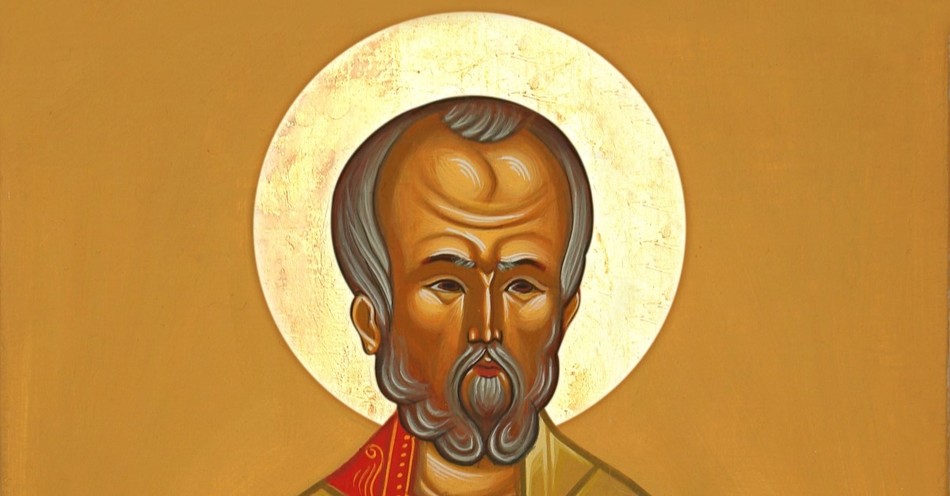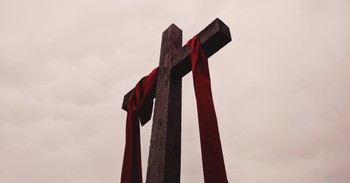Maybe you call him St. Nicholas, but have you wondered whether he's a real saint? Let's take a look at the history and traditions about St. Nicholas.
The History and Origin of St. Nicholas
St. Nicholas of Myra is a saint in liturgical Christian denominations. As with many Christian saints, he is the patron saint of a particular group. Most notably, he is a patron saint of children and sailors. According to the Encyclopedia Britannica, during the medieval period, Nicholas "became the patron saint of Russia and Greece; of charitable fraternities and guilds; of children, sailors, unmarried girls, merchants, and pawnbrokers; and of such cities as Fribourg, in Switzerland, and Moscow."
Nicholas is believed to have been born in Patara, a city in the province of Lycia (part of modern-day Turkey). After becoming a Christian, he became bishop of a church in Myra, another town in Lycia. Myra gets briefly mentioned in Acts 27:5 when Paul and his travelers visit the city en route to Rome. Nicholas is believed to have been a bishop over the church in Myra during the third and fourth century. His traditional birth and death dates are 270-343 AD.
As with many Christian saints, records of what Nicholas did are hard to verify and do not always agree. Historians Jean Blacker, Glynn S. Burgess, and Amy Ogden summarize some key ancient documents that refer to him:
- Procopius reports that the Eastern Roman emperor Justinian the Great ordered a church dedicated to St. Nicholas and St. Priscus in Constantinople be renovated. The church may have been built as early as 490 AD.
- Theodorus Lector wrote a document in 515-520 AD that lists Nicholas of Myra as one of the bishops present at the Council of Nicaea.
Joe L. Wheeler reports another key document: Eastern Roman emperor Theodosius II (401-540 AD) made an order that the Church of St. Nicholas be built in Myra.
Since primary documents written within a generation or so of someone's life are the most accurate, it's hard to say how much fact is in stories about St. Nicholas written centuries after his death. For example, a popular fourteenth-century story claims that Nicholas slapped a heretic promoting Arianism when he was at the Council of Nicaea. The council officials then defrocked Nicholas and put him in a cell, but an angel gave him his bishop garments (his miter and palium) that night. A later version of the story claims he punched the heretic, and the heretic was Arius himself.
While we may not have the most exact records we would like of St. Nicholas' life, we can say a few general things about his life based on when and where he lived. He lived during a time when the Roman empire disapproved of Christianity (it became the Roman state religion near the end of his life, after the Council of Nicaea). This means he likely underwent persecution (and possibly martyrdom). If various stories about his miracles and generosity are correct (more on that in Dan Graves' article below), then he was a charitable man who freed enslaved people and gave gifts to the poor. Ned Bustard provides a fun summary of the earliest stories of Nicholas' generosity in his book St. Nicholas the Giftgiver.
How Did St. Nicholas Become Known as Santa Claus?
Over the nearly two thousand years since St. Nicholas of Myra lived, many Christmas traditions arose around him in different countries. These traditions combined to create the American Santa Claus figure we know today, particularly because America consisted of many
We see this process in the names we have for St. Nicholas. As Dutch News explains, the story of St. Nicholas combined with other folklore elements became Sinterklaas, a gift-giving figure who travels from Spain to bring gifts during the first week of December. Dutch colonialists began coming to America in the 1600s, bringing traditions that were slowly added to other Christmas traditions. Somewhere along the way in America, Sinterklaas became Santa Claus.
A similar process gave us the name Kris Kringle, often called Santa's real name or alter ego. Vivian Bricker explains in an iBelieve.com article how Kris Kringle comes from the word Chrstkindl, German for "Christ child." Martin Luther and other Protestant Reformers seeking to bring the gospel back into Christmas celebrations suggested the idea that the Christ child brings children gifts at Christmas, which eventually developed into its own tradition.
Other elements crept in over time. Library of Congress writer Stephen Winick reports that illustrator Thomas Nast provided the definitive Santa Claus image of a man wearing a red fur coat in the 1800s. According to Smithsonian Magazine, Nast's 1866 picture of Santa in Harper's Weekly also popularized the idea he lived at the north pole.
Parents may debate whether it's healthy to let their children believe in Santa Claus, but it is well worth telling the story of St. Nicholas. It may take time to explain what is fact and what are the later stories that may be less accurate, but there is a core message in his life worth remembering: care and generosity to people who in need. While Christmas can become all about materialism if we're not careful, it should be a time to consider people we can help (in our neighborhoods, families, or around the world).

The Life and Faith of Saint Nicholas
The legend says that young Nicholas sought God earnestly, learned scriptures, fasted often, and prayed much. His parents died while he was still a young man, and he inherited their property. From the start, he determined to use it for good. He gave assistance secretly, not wishing his good deeds to be seen. For example, when he learned that a local nobleman had fallen on hard times and was contemplating selling his daughters into prostitution, he secretly threw the gold into the house to enable the girls to marry and escape degradation. Some versions say he threw the gold down the chimney where it lodged in stockings they had hung up to dry. By such tactics, he rescued many people from moneylenders and provided clothes for the naked.
Later he sailed to Palestine to tour the places where Christ had walked. On the way, says the story, Satan raised a great storm, hoping to destroy the ship. Desperate, the sailors cried to Nicholas to pray for them. He did, and the sea immediately became calm. Shortly afterward, one of the sailors slipped while climbing the mast and fell to the deck where he lay dead. In answer to Nicholas' prayers, God restored the seaman to life.
After visiting the shrines at Jerusalem, he boarded a ship for Lycia. The Lord had forbidden him to become a hermit as he wished. Plotting evil, the sailors steered in the wrong direction. Nicholas prayed. A storm arose and blew the boat to Lycia.
St. Nicholas in Myra
Myra was the chief city of Lycia. Nicholas headed to Myra. About the time of his arrival, the city's bishop died. The church seemed ready to split as its leaders argued who should be the next bishop. At that point, one of the bishops was instructed in a vision to choose the man who came to church earliest in the morning. It so happened that Nicholas was the first to the church, for he rose at midnight each night to begin his day of prayer. When questioned, he responded so meekly that the assembled bishops agreed he was God's choice.
As bishop of Myra, Nicholas resisted tyrants and taught the truth, especially rejecting the Arian heresy. His people loved him. Whereas before, he had done his acts of charity anonymously, he now realized that he must act openly, for he must be an example to his people. "The doors of his house were open to all. He was kind and affable to all, to orphans he was a father, to the poor a merciful giver, to the weeping a comforter, to the wronged a helper, and to all a great benefactor." He brought down a local temple of the goddess Diana, confronted unjust rulers, defended individuals who were falsely accused, and prayed for relief during a famine.
Nicholas attended the Council of Nicea, where he was almost stripped of his office because frustrated with the claims of Arius against Christ, he slapped him. He was required to apologize.
How Did St. Nicholas Die?
After a short illness, Nicholas died on this day, December 6, somewhere between 341 and 352. His body was laid in state in his church. A sweet substance called myrrh is claimed to have flowed from him. In the eleventh century, Italians took his relics to Bari, Italy, supposedly to preserve them from Muslim invaders. That is where they remain. It is claimed that myrrh still oozes from the relics and has a special virtue to heal the sick.
Celebrating Saint Nicholas
St. Nicholas Day, celebrated annually on December 6, is marked by the tradition of filling children's stockings or shoes left out overnight with sweets and toys. The date also honors St. Nicholas as the patron saint of sailors, making it especially significant. In Germany, Switzerland and the Netherlands, gifts are given on Nicholas's day and in the United States, on Christmas day. Russia holds him as a patron saint. In fact, on March 13, 2001, A delegation of the Catholic Archdiocese of Bari, Italy brought a portion of the relics of St. Nicholas to the Russian Patriarch as a gesture of goodwill.
Bibliography:
- Butler, Alban. Lives of the Saints. Various editions.
- Fournier, Catherine. "Saint Nicholas." Domestic Church Communications, Ltd. http://www.domestic-church.com/CONTENT.DCC/ 19981101/SAINTS/nicholas.htm
- Ott, Michael. "St. Nicholas of Myra." Catholic Encyclopedia. New York: Robert Appleton, 1914.
- Scarola, Shonnie. "St. Nicholas Day." Domestic Church Communications, Ltd. http://www.domestic-church.com/CONTENT.DCC/ 19981101/SAINTS/nicholas.htm.
- "The Life of The Holy Hierarch and Wonderworker Nicholas Archbishop Of Myra in Lycia." St. Columba Press. http://www.stmichael.org/Nicholas/ StNich.html
- "The Saint Nicholas Page." http://www.geocities.com/Athens/7175/ stnich-page.html.
- Veith, Gene Edward. "Slappy holiday; Why not take the Santa Claus tradition a little further?" World. (December 24, 2005): p. 22.
("The Body of St. Nicholas Lay in Myra" by Dan Graves, MSL, first published on Christianity.com on April 28, 2010)
Last updated November 2023
If you'd like to read more about St. Nicholas, you may enjoy these articles:
5 Things We Think We Know about St. Nicholas
3 Reasons St. Nicholas Would Not Have Wanted to Be Santa
The Real Saint Nick (and How We Need Him Today)
Who Is Santa and What Does He Have to Do with Christmas?
Photo Credit: © Getty Images/kalistenna
This article is part of our larger Christmas and Advent resource library centered around the events leading up to the birth of Jesus Christ. We hope these articles help you understand the meaning and story behind important Christian holidays and dates and encourage you as you take time to reflect on all that God has done for us through His Son, Jesus Christ!
What Is Advent: Meaning, History, and Traditions
Advent Prayers for Friends, Family, and More
What Is an Advent Wreath and How to Use One?
The History of Santa Claus: Origin of St. Nicholas
Christmas Bible Verses & Scripture Story
What is Christmas? True Meaning and Holiday History
Christmas Eve History and Traditions
Why Gold, Frankincense, and Myrrh?
When Was Jesus Born? Why December 25th
Where Was Jesus Born?



